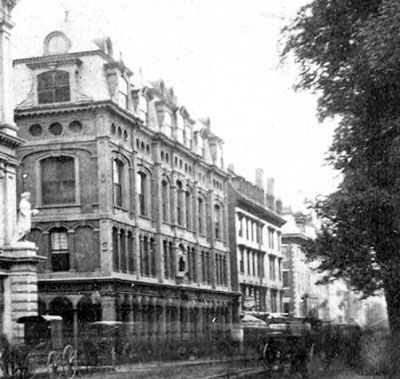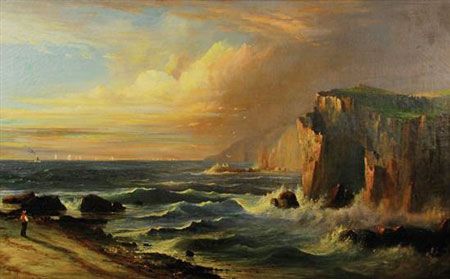To interactively explore this work, tap or click on on the artist’s name, the title, and on features in the work itself.
Oil on canvas, 20 x 40 in., McMullen Museum of Art, Boston College, 1988.332.
Tap or click on points of interest in the image to learn more ➡

Sky
While Griggs renders the sky broadly in flat areas of blue, gray, and white, the treatment is effective in its depiction of diffuse light. The dulling of colors in distant masses such as the cliffs is caused by particles in the air between the viewer and a faraway object—a phenomenon known as “atmospheric perspective.” Many American landscape painters of the second half of the nineteenth century, like Martin Johnson Heade and Fitz Hugh Lane, experimented with atmospheric light effects. Employing visible, gestural brush strokes, Griggs’s approach to light is more painterly than many of his New England contemporaries.
Cliffs

Frederic Church’s Niagara (1857) is a contemporary work intended to elicit the sublime.
Dramatic cliffs are a common feature of nineteenth-century American landscape painting. Many contemporary works feature vast, dynamic views meant to evoke the sublime—a feeling of awe and even terror at the greatness of nature. The Irish philosopher Edmund Burke popularized the sublime in art, in an essay that focused on the physiological effects of the depiction of things “dark, uncertain, and confused.” In America, Ralph Waldo Emerson saw natural beauty, viewed in solitude, as the manifestation of the divine. American painters like Frederic Church and William Morris Hunt painted vast scenes of mountains, forests, and waterfalls, with an eye to the movement of water, clouds, and light, with great specificity and detail, following the instruction of influential critic John Ruskin: “Every class of rock, every kind of earth, every form of cloud, must be studied with equal industry, and rendered with equal precision.”
The rock walls depicted here are typical of the granitic formations that occur along the Coastal Volcanic Belt, a line of igneous cliffs and crags extending from Massachusetts to New Brunswick.
Seagulls
The lightly colored bodies and sharply contrasting black wingtips suggest that these are herring gulls, the most common gull in Maine and the Northeast.
Waves
One of the painting’s more engaging passages is this line of breaking waves, which effectively depicts sunlight diffused through moving water. The translucent effect is the result of building the color in a series of semi-transparent glazes, an academic technique dating back to the Renaissance.
Figures
Griggs renders his figures more sketchily and less precisely than he does the landscape. The figures’ loose-fitting blouses and simple trousers may indicate youth. Their flat, wide-brimmed hats, resembling those of the Amish, point to country life—by mid-century, top hats and form-fitting pants were the popular fashion for men in urban centers.
Steamboat

The S.S. California (1848) was a side-wheeler that was the first steamship to travel from Central America to North America.
The earliest steam engines date to the eighteenth century. In North America, steam became a major form of transportation after Robert Fulton’s 1807 development of a commercially viable model of boat. In the years leading up to the Civil War, paddle boats were a mover not only of cargo but also of people. By the 1850s, rail transportation had begun to compete with paddle boats for passengers with the result that after the Civil War steamboat travel diminished precipitously; soon after that, screw propellers made paddle boats obsolete.
In contrast to the familiar rear-wheeled paddle boats of Mark Twain’s stories, this ship is a side-wheeler, a design favored for coastal waters because of its superior steering. Side-wheeling frigates had been used for naval combat in the Civil War. Griggs does not indicate whether his ship is military or merchant marine.
For more information on the Custom House, visit the City of Boston’s Buildings We Love.


